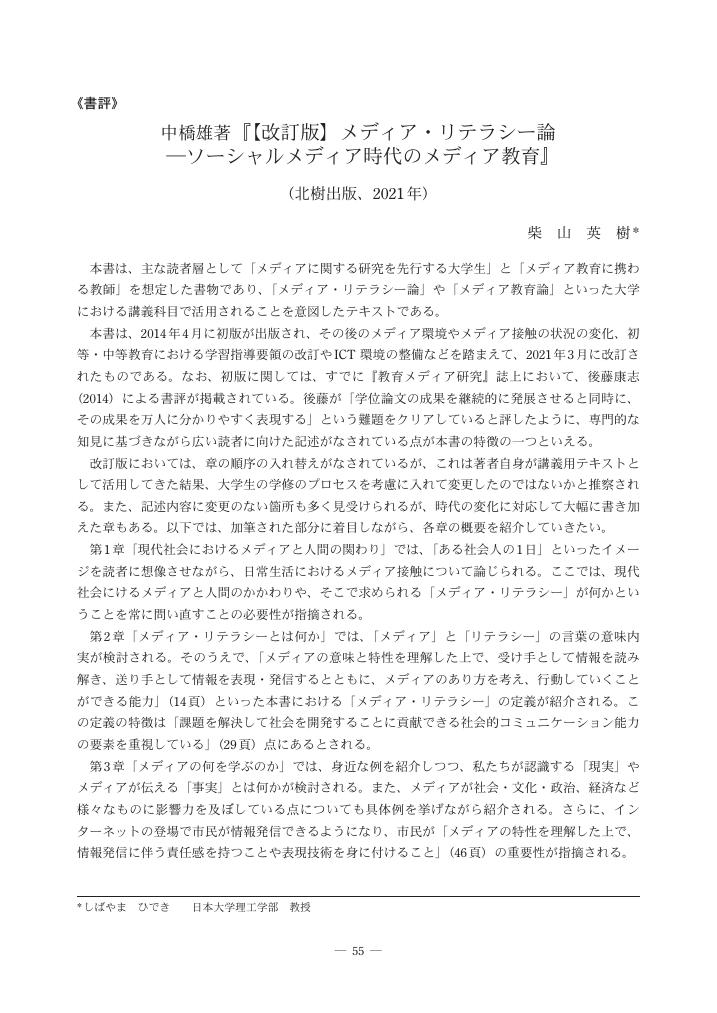2 0 0 0 OA シュタイナーの色彩論に関する思想史的考察
- 著者
- 柴山 英樹
- 出版者
- 教育思想史学会
- 雑誌
- 近代教育フォーラム (ISSN:09196560)
- 巻号頁・発行日
- vol.14, pp.193-209, 2005-09-18 (Released:2017-08-10)
本稿は、ルドルフ・シュタイナーの色彩論について、19世紀末から20世紀にかけて展開された科学的色彩論やクレー、カンディンスキーなどのバウハウスの教師たちの色彩論などの同時代のコンテクストから読み直すことによって、シュタイナーの色彩論の意味内実をより明確に捉えられることを示したものである。シュタイナーは、色彩と身体のつながりを二元論的に捉えようとする科学的色彩論から距離を置き、ゲーテの色彩論における実在論的視点からの影響を受けつつ、進化論的視点という独自の視点に立脚した一元論的な色彩論を提示したのである。シュタイナーは、実在論的視点や進化論的視点に立脚することによって、自然界における色彩現象と人間の身体や感覚とのつがなりを解明し、そこから導き出された色彩が直接身体や感覚に働きかけてくるという観点に基づき、色彩を通じて自然の生成過程を追体験する絵画方法を提示したのである。
2 0 0 0 OA 文字と教育の思想史(Colloquium 2)
- 著者
- 柴山 英樹
- 出版者
- THE SOCIETY FOR EDUCATIONAL RESEARCH OF NIHON UNIVERSITY
- 雑誌
- 教育學雑誌 (ISSN:02884038)
- 巻号頁・発行日
- vol.58, pp.55, 2022-03-25 (Released:2022-03-25)
- 参考文献数
- 3
- 著者
- 柴山 英樹
- 出版者
- 教育哲学会
- 雑誌
- 教育哲学研究 (ISSN:03873153)
- 巻号頁・発行日
- vol.2005, no.91, pp.66-84, 2005-05-10 (Released:2010-05-07)
- 参考文献数
- 44
This paper describes an aspect of Steiner's discourse concerning “Body, ” “Rhythm, ” and “Education.” At first, the author will analyze Steiner's lectures in 1923 on “Muse Education” in ancient Greece, because this concept and his educational practice sustain an important relationship. Steiner envisages the viewpoints of “Rhythmic System” and “Synesthesea” from the antcient Greek idea of the universe. These viewpoints enable him to adopt “Art Education” in his educational practice.Here, the author will compare Steiner's discourse with the thought of Dalcroze, a contemporary philosopher. Dalcroze and Steiner give their thought to the relation of the human body and rhythm, an Aporia for 19th century science. By appropriating the evolutionary theory in the different contexts, both try to explicate the mechanism of the relation between body and rhythm. Each identifies a distinct “Organ of Sense, ” and tries to develop it respectively. But their difference ultimately drives from linguistic definitions. Steiner's “Euryhtmie” consists in the rhythm and gesture which consist in the rhythm and gesture as defined by language.Moreover, the beginning of the 20th century has discovered various “rhythms.” Krieck takes up the rhythm that promoted the moment of festivity as well as human mobilization to community. Dalcorze mentions the rhythm which facilitated human adjustment to the external environment. Steiner points to the inner rhythm of life and to that of words as logos. Although the author has analyzed the same word “Rhythm”, he found its various meanings.The discourse on the connection of “Body, ” “Rhythm, ” and “Education” indicates different possibilities and dangers which may attend various rhythms. Dalcroze notes the power of rhythm which promotes individuals' involvement in the community. By comparison, Steiner emphasizes the transcendental relations between the universe and individuals, and he explores a vision of the rhythm and education distinctly different from that for the formation of community.


